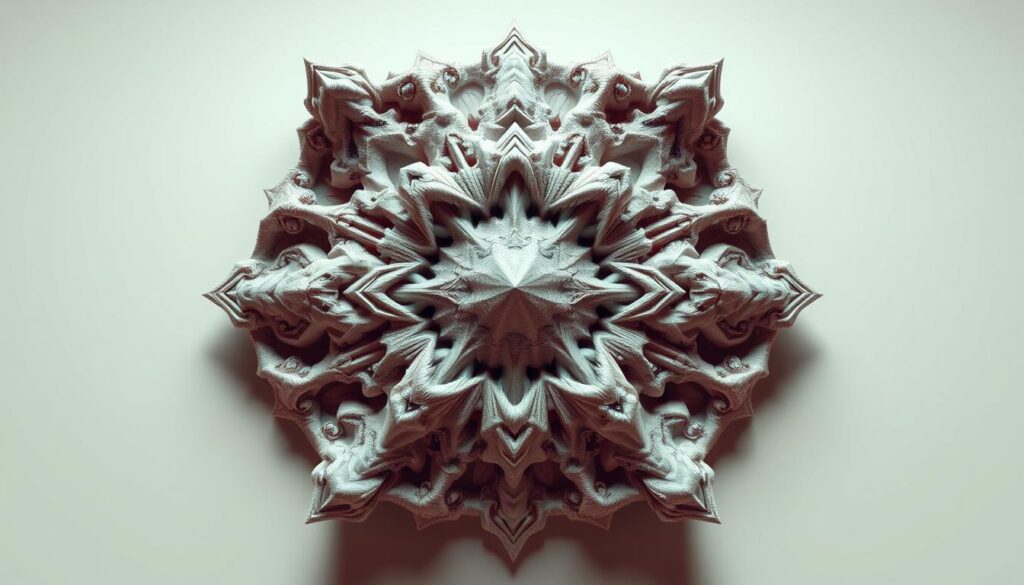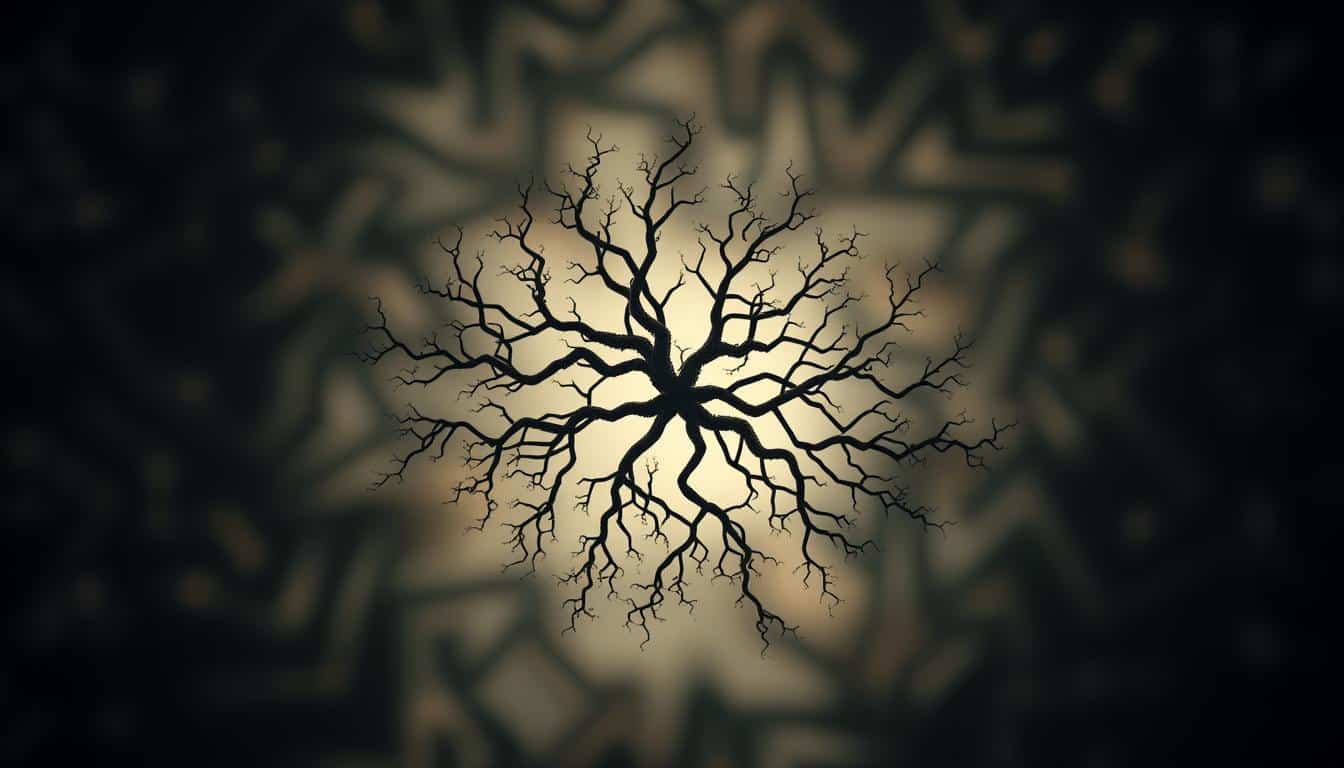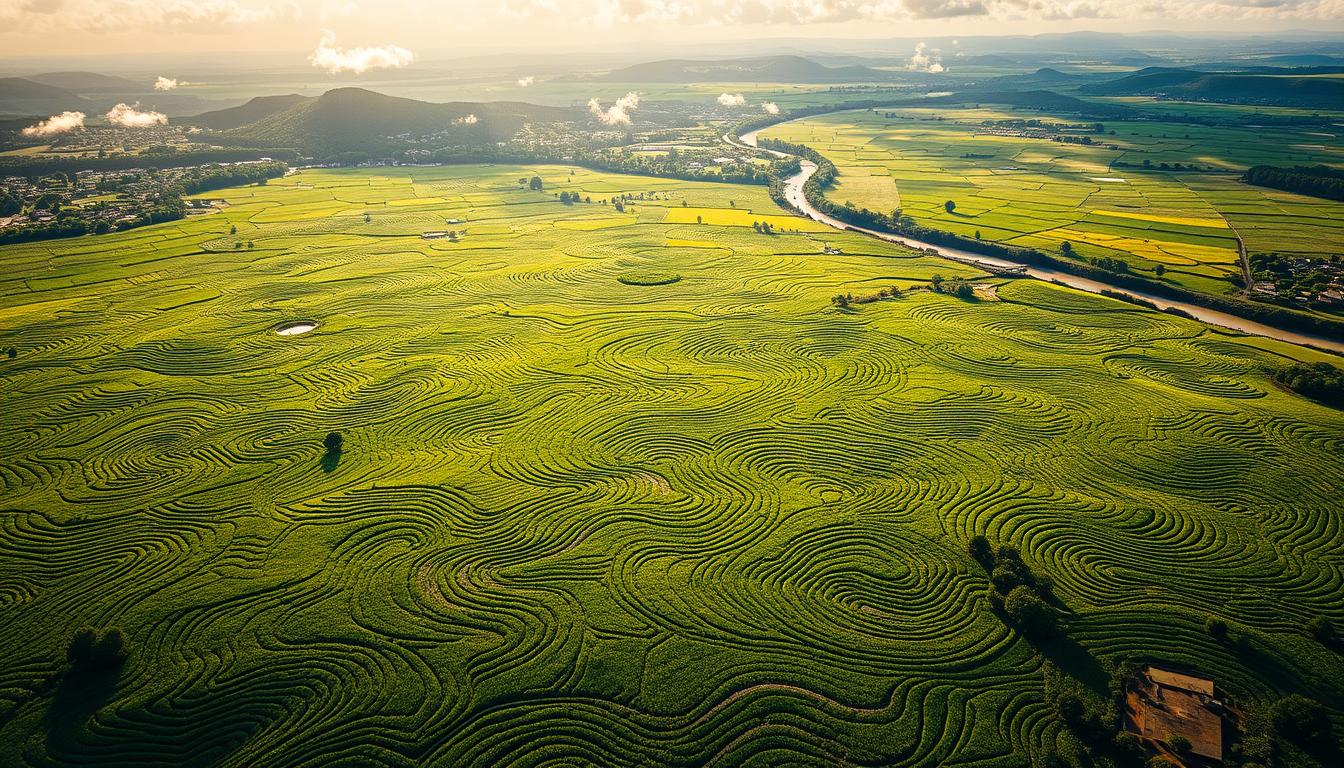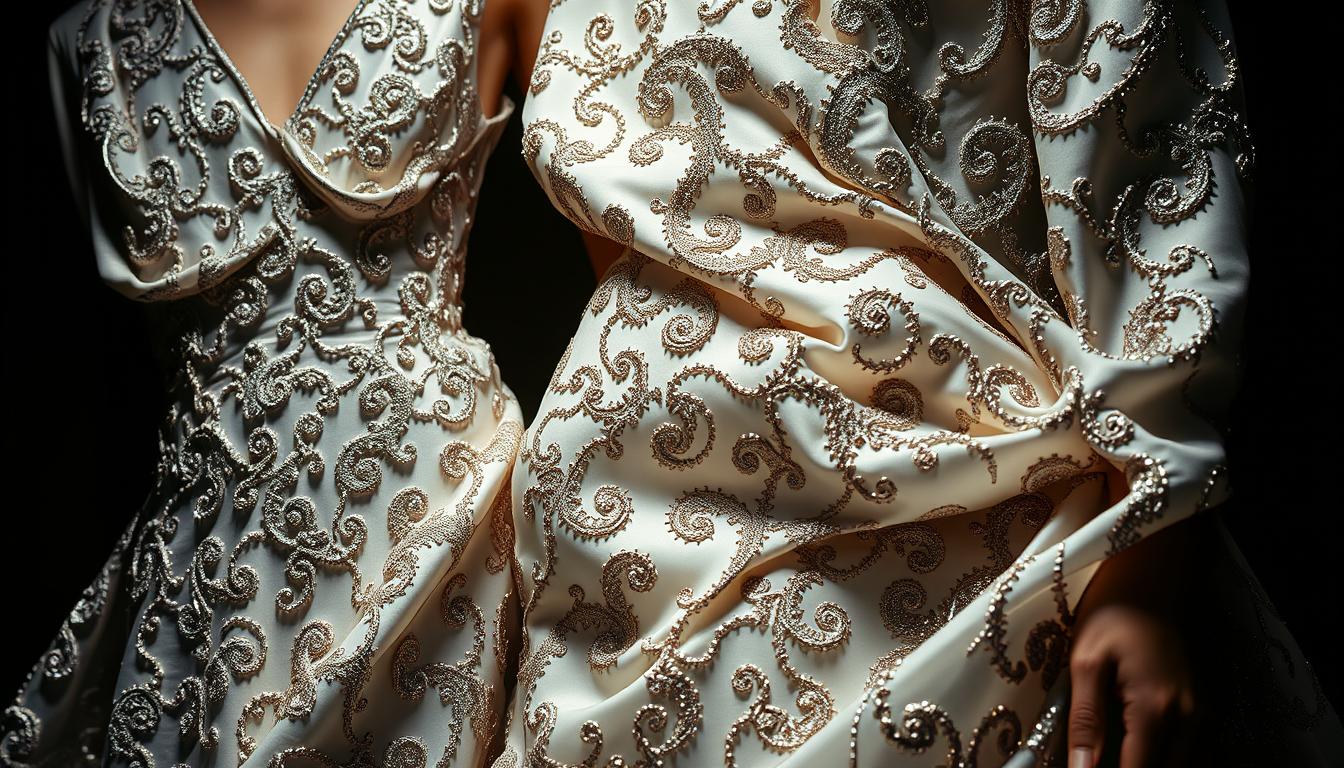Fractal geometry shows us the beauty of traditional architecture and textiles. It lets us see how culture, identity, and art come together in patterns. These designs are more than just pretty; they help us understand how geometric shapes influence art and places we love.
By looking at fractals in history and their use, we can see their lasting effect on modern art. This exploration helps us value the deep roots of these patterns in culture.
Understanding Fractal Geometry
Fractal geometry is a unique branch of math. It looks at complex shapes with patterns repeating on many scales. These patterns, or self-similarity, help us understand natural and man-made things better. Learning about fractals lets people see the beauty in various fields, like art and architecture.
The Basics of Fractal Geometry
Fractal geometry focuses on shapes made from simple repeating steps. At its heart is self-similarity. This means a shape looks the same close up or far away. This feature can be seen in clouds, shorelines, and mountains, linking fractal geometry to the natural world.
Studying these patterns reveals the deep order and complexity of our surroundings.
Historical Context of Fractal Geometry
Fractal geometry’s history goes way back, before it got its official name. In the late 20th century, Benoit Mandelbrot revolutionized it with his book, “Fractals: Form, Chance, and Dimension,” in 1977. He showed the world the math behind fractals. However, fractal-like designs were in art and architecture long before. Cultures around the world used fractal designs, enriching our appreciation for structures that show this amazing geometry.

The Influence of Fractals on Cultural Patterns
Fractal patterns are found in both nature and culture. They show beauty, complexity, and unpredictability. Cultures use these patterns in architecture and textiles. This shows how fractals, nature, and culture are connected.
Fractal Patterns in Nature and Their Cultural Significance
Fractals are everywhere in nature, like coastlines and mountains. They show how complex nature is. Cultures use these natural forms in art and building. This connects cultural designs with the natural world around us.
How Fractals Reflect Cultural Identity
Fractals help show cultural identity. They are used to tell stories and share history and beliefs. Cultures around the world use fractals in their art. This highlights fractals’ role in culture and continuity.
Fractal Geometry in Traditional Architecture and Textiles
Fractal geometry is crucial in both traditional architecture and textile design. It combines beauty with function in an amazing way. We’ll look into how traditional architecture is defined and how fractals influence textile patterns.
Defining Key Features of Traditional Architecture
Traditional architecture is known for its unique features. These are deeply tied to cultural heritage and adapting to the environment. Fractal patterns are seen in these buildings, creating harmony with nature and cities. Important features include:
- Organic shapes that mimic natural forms
- Repetitive motifs that create visual coherence
- Symmetry and balance in design that enhance aesthetic appeal
Fractals make buildings more beautiful and well-integrated with their surroundings. This fosters a strong sense of place and identity.
Impact of Fractal Geometry on Textile Patterns
In textiles, fractal geometry is used to make complex, repetitive patterns. These patterns often have significant cultural meanings. They can tell stories or symbolize cultural icons, making a deep connection with people. Studies have shown that these patterns can make fabrics more appealing and emotionally engaging. The benefits include:
- Enhanced visual interest through complexity
- Creation of layers that invite exploration
- Potential to evoke specific emotional responses based on the design
Using fractals in designs lets creators tell stories and spark emotions that mirror their cultural stories.
The Role of Fractals in Islamic Architecture
Fractal geometry is key in defining Islamic architecture’s beauty and spiritual depth. We see this math concept across history, in designs that blend harmony with the divine. Today’s use of fractal patterns mixes old traditions with new ideas. This makes sure they stay important even in modern designs.
Historical Examples from Islamic Culture
Islamic buildings are known for their complex fractal designs. Places like mosques and palaces display stunning tilework with these patterns. They show a divine beauty and order. This lets people see Islamic design’s complexity and precision.
Examples include Spain’s Alhambra and Iraq’s Great Mosque of Samarra. Their fractal patterns bring a sense of unity and spirituality. This feeling is a big part of Islamic culture.
Contemporary Applications of Islamic Fractal Patterns
Today’s architects take cues from Islamic fractals for their projects. Using fractal geometry, they create new looks that respect their roots.
Things like Mashrabiyya screens in modern buildings show how these patterns have evolved. This blends old art traditions with new ideas. It ensures ancient designs will keep inspiring people.
Fractals in Global Architectural Styles
Fractals hold a big role in global architecture, showing how different cultures use geometric patterns. By comparing styles worldwide, we see fractals in many forms. They range from natural shapes in organic designs to complex geometries. This shows the artistic uniqueness of each region.
Comparative Analysis of Global Architectural Styles
Looking at global architecture, fractals vary by culture and setting. For example:
- Western architecture often uses symmetry and proportion, with fractals in grand shapes.
- African architecture has repeating motifs, using fractals for symbolic meanings in buildings.
- Asian architecture uses fluid curves and repetition, connecting with nature.
Fractal Geometry in Asian Traditional Architecture
In Asian architecture, fractals highlight harmony with nature. Key traits reflect fractal principles:
- Buildings show intricate repeating details, creating visual rhythm and appeal.
- Curves help structures merge with landscapes, echoing natural shapes.
- Designs express cultural beliefs, with fractals showing connectivity and balance with nature.
Visual Integration of Fractal Patterns in Urban Design
Fractal integration in urban design provides a unique way to understand and shape our cities. It uses fractal geometry to create spaces that are efficient and reflect cultural identities. This method makes it easier to adapt to changes in our fast-moving world.
Fractals as a Tool for Urban Planning
Urban planners see cities as fractal systems. This view helps them see how different parts of a city connect. Using fractal geometry, they can design spaces that are natural and meet people’s needs.
Cities based on fractal principles are easier to get around and more accessible. This approach helps cities grow with their communities. It supports ongoing development that’s good for the environment.
Cultural Impacts on Urban Fabric Based on Fractals
Using fractals in urban design changes the city’s look and feel. Cities with fractal designs reflect the culture of their people. They make people feel like they belong by using patterns and shapes that have meaning.
Buildings influenced by local stories and social values connect more with the community. This deepens the connection people have with their city. It makes urban living fuller and more enjoyable.
Evaluation of Fractal Geometry in Textiles
The study of fractal geometry in textile design is deeply rooted in tradition and creativity. Throughout history, many cultures have used fractal patterns in their textiles. These patterns tell stories, share beliefs, and express artistic styles. This long history shows how fractals continue to inspire vibrant and meaningful fabric designs.
Historical Development of Textile Design Using Fractals
Fractal elements in textile design go way back and connect to cultural symbols and values. Examples include:
- Traditional Patterns: Textiles from places like Persia and India display complex fractal designs that have lasted for ages.
- Cultural Significance: Fractal designs in textiles often represent spiritual beliefs, echoing nature and human life.
- Artistic Expression: Artists used fractal geometry to craft eye-catching patterns, adding depth to each fabric’s story.
Fractal Geometry as an Innovative Design Approach
In modern textile design, innovation is key, with fractal geometry being a prime example. Designers today use fractals to:
- Create Unique Patterns: Fractals open up new paths for creative design, leading to unique and fresh looks.
- Enhance Aesthetic Appeal: The natural appeal of fractals draws the eye, making fabrics more attractive.
- Improve Structural Integrity: Fractals’ math helps make textiles that are not just pretty but also strong and useful.
The Box-Counting Method for Analyzing Fractals
The box-counting method is key in studying fractals, helping to explore designs in architecture and textiles. It measures the fractal dimensions of objects to understand their complexity. This shows how scale and self-similarity interact in these designs.
Understanding the Box-Counting Method
Researchers place a grid of boxes over the object they’re studying. They look at how the number of boxes needed changes with the box size. This gives architects insights into how designs are organized. It reveals the beauty and usefulness of patterns found in nature and cities.
Application of the Box-Counting Method in Architecture and Textiles
Many studies show how this method is used in architecture and textiles. For example, it helps understand urban spaces by looking at building interactions. In textiles, it uncovers complex patterns that make fabrics more interesting. This improves both the looks and functionality of new designs.
Fractal Concepts in Urban Planning and Architecture
Fractal concepts give us a special way to look at city planning and architecture. Cities grow in complicated patterns similar to fractals in nature. Knowing these patterns helps us design places that work well and are good for the environment.
Urban Environments as Fractal Systems
More and more, city planners see cities as fractal systems shaped by their history and social ties. This view points out how every part of a city is connected. Key features include:
- Self-similarity: Urban design patterns often repeat on smaller scales.
- Complexity: The way elements are related creates a complex network of interactions.
- Adaptive growth: Cities naturally change, showing how culture and technology evolve.
Using fractal concepts in city planning can improve how we use resources, handle changes, and build community relationships. By adopting these concepts, urban designers create spaces that look good, feel alive, and are kind to the planet.
The Psychological Impact of Fractal Designs
Fractal designs have a special power over how we see and feel. These patterns are both organized and complex, drawing us in. They make places like buildings and clothing more enjoyable. By understanding their effect, we learn how art connects to our happiness.
Fractals and Human Perception
Studies show fractals really improve how we see the world. They bring a sense of balance that is pleasant to look at. This mix of repetition and change catches our attention in a good way. It makes all kinds of spaces feel better to be in.
Fractal Patterns and Emotional Responses
The detailed nature of fractals can make us feel calm and cozy. When buildings use fractal designs, people tend to feel happier inside them. This effect is key in architecture for creating spaces where we feel good. It can lead to more joy and contentment in our lives.
Challenges and Critiques of Using Fractal Geometry
Fractal geometry is popular in many areas, like architecture and design. But, using this theory comes with big challenges and critiques. Understanding these can show us the complex nature of putting fractal theory into action.
Developments in Fractal Theory
New developments in fractal theory show it has its limitations. A big hurdle is how to define fractals in different settings. Even though math gives us clear definitions, applying these in art and design can cause confusion. Trying to mix artistic goals with math can lead to clashes between being creative and sticking to strict rules.
Critiques from the Architectural Community
Some architects have criticized using fractal concepts too much. They think relying heavily on math might limit creativity and new ideas. This criticism suggests a problem: when focusing on fractals, the aesthetic part might get lost. This sparks a big discussion on finding the right mix between good looks and being practical.
Conclusion
Studying fractal geometry in old architecture and textiles shows a deep link between math and culture. Different cultures use fractals to show their unique beauty and identity. This mix of old and new ideas helps create fresh designs in buildings and clothes.
Using fractals in today’s city planning and architecture is key. It can make cities feel more connected to their past. This means we should keep looking into how fractals can make our surroundings look better and carry cultural stories.
Exploring fractals keeps our creativity alive. It leads to new design methods that make both buildings and clothes more interesting. Knowing about fractals is crucial for mixing art with science, ensuring our future has spaces that are both beautiful and practical.



